An uninvited guest occasionally drops in on Kay Buetow's Newport home — a pungent scent she calls "sweet garbage."
"I cannot enjoy gardening, being out in my yard," said Buetow, who lives near an industrial area. "It gives you a migraine."
From rotting meat to roasting coffee, odors are an invisible byproduct of the industries that make urban living possible. But behind the scenes in the Twin Cities, a growing network of governments, companies and consultants is hard at work sniffing the air in an increasingly sophisticated quest to identify and tamp down offending odors that harm residents' quality of life.
In the east metro, Newport leaders are mulling new rules cracking down on odor emitters, modeled after recent rules in neighboring South St. Paul. Minneapolis began routinely monitoring certain problem businesses for smells several years ago and plans to tighten up its ordinance this year. Cottage Grove recently required a new marijuana growing facility to regularly take whiffs of the air and submit reports. The Metropolitan Council even owns an "odor lab," where people sniff bags of air captured from wastewater pipes and plants.
But regulating smells is tough work, even with modern tools to measure them more precisely, because it can be difficult to track them back to their source, and not everyone agrees which ones are bad. Minnesota nixed its state odor rules in the 1990s, leaving the task largely up to cities.
"Some people don't like the smell of dryer sheets," said Jim Doten, Minneapolis supervisor of environmental services, who occasionally gets calls about fragrant laundromats among other businesses. "What some people tolerate, other people don't."
Layers of scent
Few enjoy the smell of trash, however, which is why consultants regularly hunt for odors around a Newport garbage facility run by Ramsey and Washington counties. Hennepin County staff head out every weekday when odors are ripe in the summer, searching for scents around the downtown garbage burner beside Target Field — a building equipped with high-speed doors to help trap smells inside.
"When you get a big gust of wind, there's patterns involved in what odors become apparent," Jill Morris, an environmental engineer with the Foth Cos., a consulting firm, said during a recent test around the Newport garbage plant. Sometimes she picks up strong meat-rendering smells — likely from a facility across the river — mixed with an "undertone" of garbage.
"You get layering," said Jennefer Klennert, a Foth principal consultant. "It's almost like a fine wine."
At the center of a lot of this work is a tool that looks like a radar gun held to the nose. The Nasal Ranger, an olfactometer created by Stillwater-based St. Croix Sensory, measures the concentration of odors by allowing users to smell them through different levels of filtration. Designed just over 15 years ago, it's used by regulators to sniff everything from landfills in Hong Kong to compost in California.
The Twin Cities smell better than they did several decades ago, as some pungent industries like asphalt plants have consolidated or moved out of the urban core, said Chuck McGinley, St. Croix Sensory's technical director. But citizen expectations fluctuate.
"The bar in odor in the community is being lowered," McGinley said. "What may have been acceptable 10 years ago may not be acceptable now in that same community."
South St. Paul, former home of massive stockyards and still the site of related industries, has the most advanced odor regulations in the metro area. It uses the Nasal Ranger to assess if complaints meet a certain threshold and asks repeat offenders to submit an odor management plan. An "odor wheel" helps delineate one smell from another, with categories ranging from "dead animal" to "petroleum" and "dog food."
"We needed a way to figure out what was going on and to objectively be able to say what level the odor was," said Peter Hellegers, the city's planning division manager.
Legal fight
Enforcement can be tricky, though. Rendering company Sanimax took the city to court last year after being tagged as a significant odor generator, arguing the ordinance was unconstitutional. The company's South St. Paul plant helps turn the region's leftover meat into animal feed and fat-reliant products like lubricants, soap and even car tires. The city ultimately rescinded its "significant odor generator" label.
Donn Johnson, Sanimax's general manager of U.S. operations, said that smell is unlike noise, which can be easily regulated by decibel readings. He calls the Nasal Ranger "a very controversial piece of equipment."
"Odor is very subjective. And it's different, person to person to person," Johnson said. The company has invested in equipment to reduce odors and monitors the neighborhood twice daily.
Minneapolis also has a special odor regulation, but staff are hoping this year to clarify in technical terms what is now a vague prohibition on odors that interfere with "the reasonable and comfortable use and enjoyment of property."
"What you're willing to put up with really varies. Who's reasonable? What's reasonable?" said Doten, whose staff responds to complaints and routinely monitors some problem businesses like a shingle manufacturer on the North Side.
Underground smells
The Metropolitan Council spends about $4 million a year controlling odors from the region's wastewater, which it collects through more than 600 miles of pipe and eight treatment plants — and it has increased its odor control efforts in the past decade. Dozens of odor control units scattered around the metro area treat and release pressurized air from the pipes without stinking up neighborhoods. That air is bagged and sent to the east side of St. Paul, where "panelists" trained by St. Croix Sensory sniff them using a special machine to measure and characterize any smells.
"What you're trying to avoid are the 'putrids' and the 'vomit' and 'sewer,' and those types of things," said Lisa Wolfert, the Met Council's senior environmental scientist. "That's when we know there's a problem."
In many cases, the Met Council's odor control units remove smells by venting air through a bed of compost and mulch, where microorganisms feed on the odorous compounds.
Ten states, including North Dakota, have statewide odor regulations. Minnesota was one of them until 1996. Cities now handle the issue, and Newport's planning commission will meet next month to continue discussing an odor ordinance. It might help with some smells that drift across the river to South St. Paul, too.
"It really is a regional issue," said Hellegers of South St. Paul. "So it is tough trying to deal with it city by city. So having more cities that have similar regulations helps."

Want to share info with the Star Tribune? How to do it securely

'Safe recovery sites' would offer syringes, naloxone and more to people using drugs. The plan could be in peril.
New Minnesota GOP leaders seek peace with party's anti-establishment wing

Who is Republican Lisa Demuth, Minnesota's first House speaker of color?

